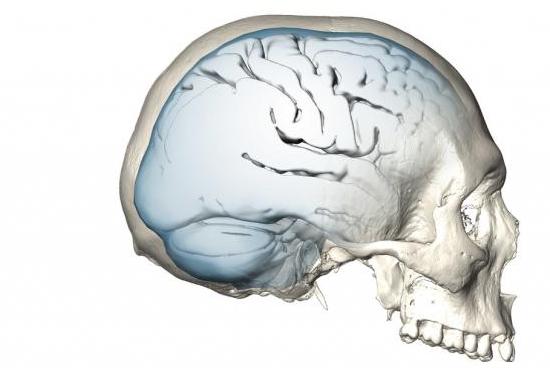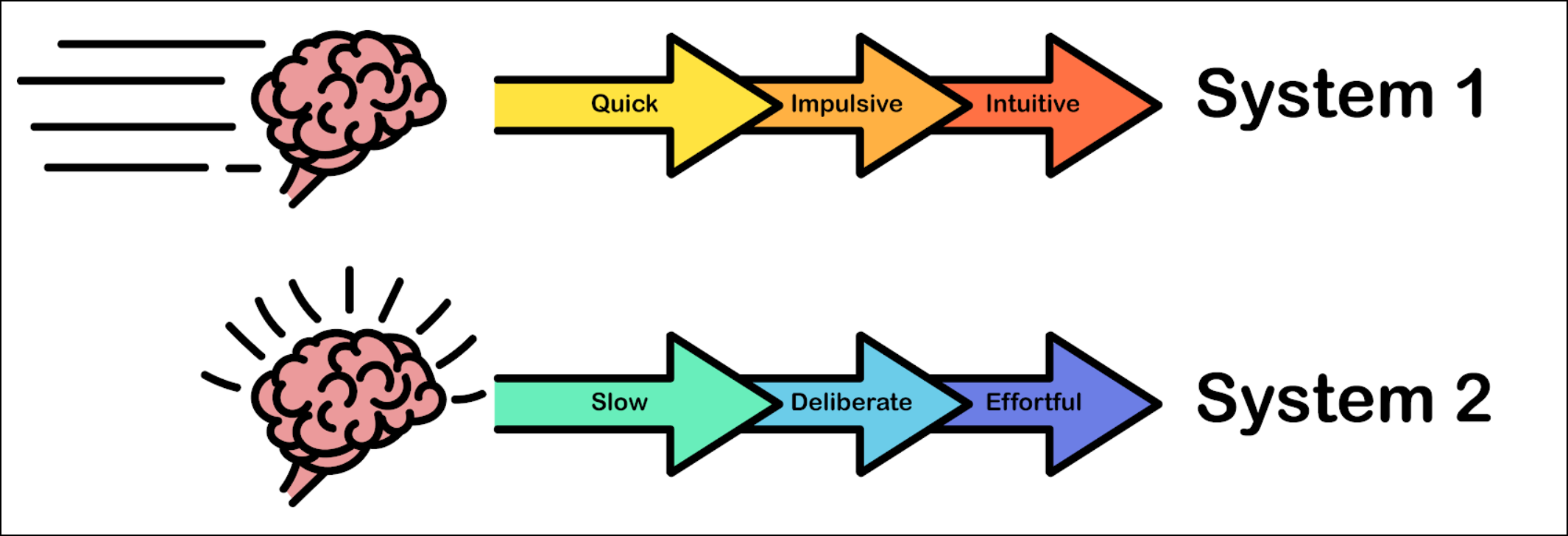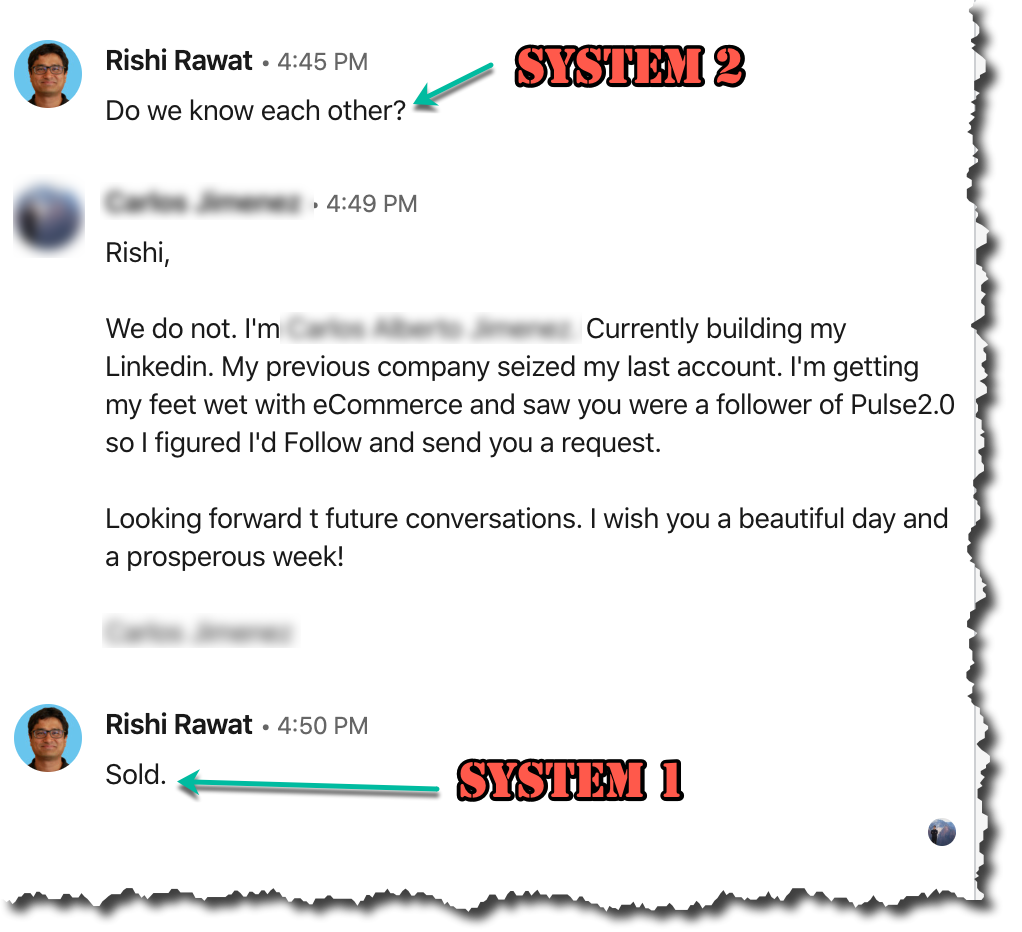Blog
Shopper Psychology: System 1 Versus System 2
At the heart of buyer behavior is our beautifully mysterious Homo Sapien brain.

This 3-pound organ is singularly responsible for understanding the universe and choosing between one and two-ply toilet paper.
Our brains are incredibly busy. And to say incredibly busy is an understatement.
I tear up thinking about how amazing the brain is (want to peek inside my head?).
Because the world is so incredibly complex and busy (we are exposed to 20,000 products every single day) nature has designed a whole set of decision shortcuts.
This is where System 1 and System 2 come in. It’s a framework developed by Dr. Daniel Kahneman—a brilliant behavioral economist.
Here is a quick visual summary:

Video Explanation of System 1 and System 2
⌄ video transcription
If you want to improve your conversion rates, you’re going to have to understand the mind of the shopper. And if you want to understand the mind of a shopper, you need to understand how the shopper’s brain works. And in order to understand the shopper’s brain, I can think of one simple model that really simplifies our understanding. That is to imagine the brain as a two-part system: System 1 and System 2.
System 1 is impulsive and fast.
System 2 is slow and methodical.
Shoppers have a preference to activate System 2 because System 2 is what helps us see the world for how it is. But System 1 is a high-energy mode so our brains have an incentive to use it sparingly.
I’ve thought a lot about a simpler way of explaining System 1 and System 2. Recently, while walking, had a breakthrough of sorts.
Think of System 1 as your finance department, and think of System 2 as your accounting department. So, System 2 looks at the world as black and white, just like an accountant does. Finance, on the other hand, is all about the future implication of an investment today. That’s what System 1 is always focused on.
Again, this is not a perfect analogy because really System 1 does not look into the future, but I think the way System 1 makes decisions is more akin to a finance person, versus an accountant. So, let’s understand what is the difference between finance and accounting. If you would open a new retail store, let’s say that you knew that Santa Monica is a growing market and you want to open a retail store.
You’re going to have to spend a lot of money to open a retail store, you’re going to have to spend a lot of money to get licenses, you’re going to have to spend a lot of money to train people, and it’s going to take at least a year before the store is getting the right kind of foot traffic, you know, you’ve worked out all the kinks, you’ve trained your staff, all of that good stuff.
Now, from an accounting perspective that is a black hole. An accountant would simply look at your finances and say, “Look, you have spent one year on this location in Santa Monica, this is the rent, this is how much we’re paying for training.” and they’re looking at it purely from a cost perspective, and you will get one version.
However, the finance department will look at it differently. They will look at the growth of the demographics in the Santa Monica area, they will look at the trend lines for foot traffic, they will look at trend lines for returns, they will look at the impact of word-of-mouth, they look at all of these other metrics that give you an idea about the future, and likely draw a totally different conclusion.
So, that’s how you should think about System 1 and System 2. These are two different parts of the brain. Hopefully, this analogy has given a better insight into how System 1 makes decisions versus how System 2 makes decisions. If you have any questions, comment below and I’ll be happy to answer them.
Did the video help? /
🙌
Uh oh! Let's get in touch so I can explain this better.
We'll talk soon!
Systems 1 and 2 Help Us Navigate the World
System 1 is used to make rapid decisions. It’s the default state of the brain. How are you feeling today? The first thing that came to mind was delivered via System 1.
System 2, on the other hand, is used to make important decisions. When you are holding your newborn niece you are 100% in System 2 mode.
There is one important detail we should mention here: System 2 is lazy. Incredibly lazy.
And this is by design. Thinking takes up significant brainpower. And evolution is all about smart energy usage. So the brain has millions of controls to manage energy usage. Using System 2 sparingly is at the core of this energy policy.
The policy is: for all simple decisions go to System 1. Only bother System 2 for the important stuff.

Since you're liking this article on System 1 versus System 2 you're gonna love the conversion ideas I share in my weekly newsletter. Signup below. If it isn't as good as I'm making it sound unsubscribe with one click.
When System 2 is away System 1 is at the wheel.
There are 2 more details we should mention about System 1:
– It’s short-term focused. It seeks immediate gratification.
– It’s emotionally charged. Angry, happy, excited, depressed, irritated, blissful. All those feelings.
To influence buyers you need to influence their System 1. Don’t bother with System 2. It’s too smart for us.
Up until very recently, every economic behavioral model assumed all purchase decisions were System 2 driven. Thanks to fMRI technology we know the truth, which is that economists were wrong.
System 1 plays an influencing role behind nearly all purchase decisions. The degree might vary.
I know what you’re thinking, “No way that’s true. I bought a new car last year. Spent 3 months researching. Test drove 7. Read Consumer Reports. And then pulled the trigger. That was 100% a System 2 decision.”
Hate to burst your bubble but it most likely wasn’t. You probably decided on the car long before reading Consumer Reports. Maybe someone you admire/envy had that car or maybe fell in love with the color. But you can’t possibly tell yourself this is why you spent $32,000, so you do what all consumers do: you use System 2 (safety rating of the car, fuel efficiency, overall Consumer Reports ranking) to justify a System 1 experience.
The conscious mind thinks it’s the Oval Office when, in reality, it’s the Press Office. — Jonathan Haidt
Does this make sense? /
🙌
Uh oh! Let's get in touch so I can explain this better.
We'll talk soon!
Real Scenario
Received a LinkedIn connection request from someone I didn’t know.
So I replied with “Do we know each other?”
This was my System 2 mode (rational side): I only want to connect with select people.
Notice how quickly I switched to System 1 (conversation thread below):

Here’s the Deal
Understanding System 1 versus System 2 differences is an excellent starting point. But if your final destination is to improve actual sales, you need a step-by-step guide.
Your site visitors aren’t created equal.
And you don’t have the energy to chase everyone.
But what if there was a way to zero in on those who were most likely to buy?
That’s been our quest for the past 14 16 years:




